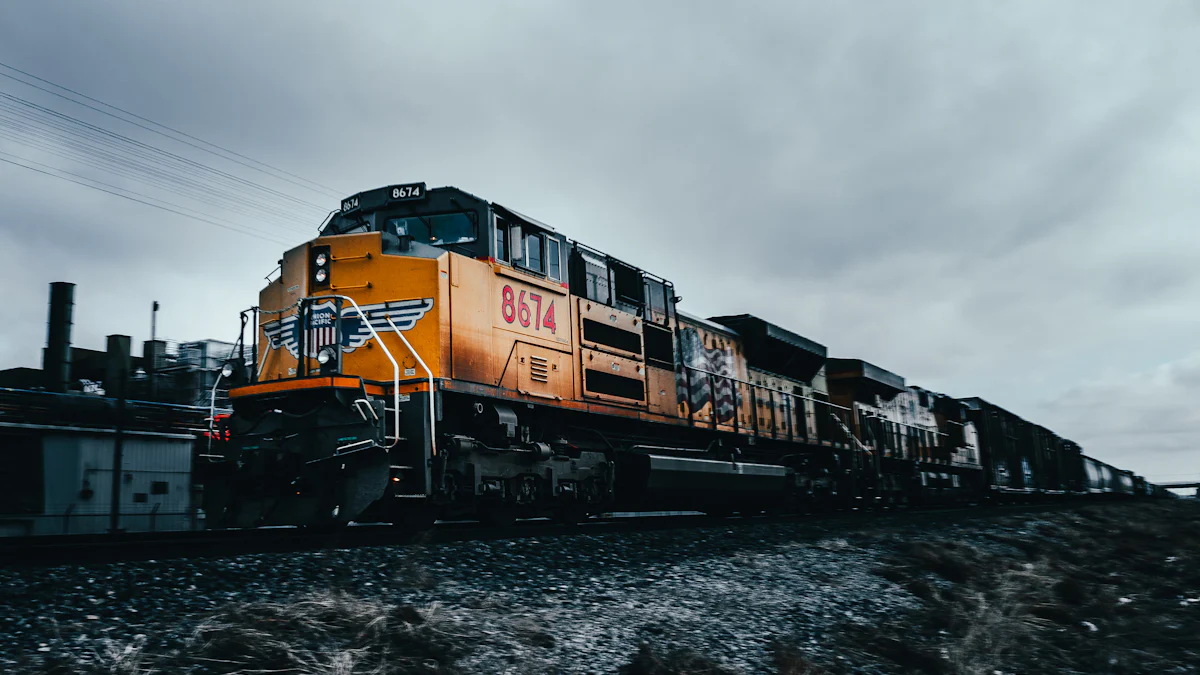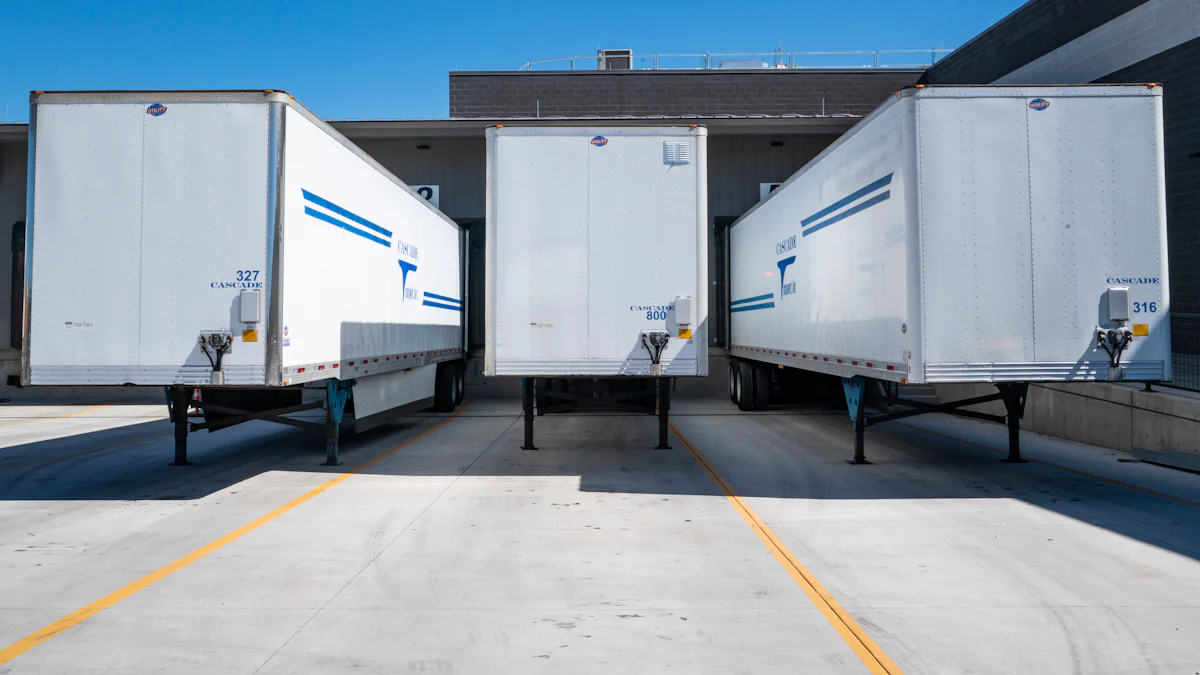Logistics Revolution on Rails: Europe's Bold Move Forward

The Logistics Revolution is transforming how goods move across Europe. Railways play a crucial role in this transformation. The European Union aims to double the share of rail freight by 2030. This ambitious goal requires significant investment and innovation. In 2022, rail transport accounted for 17.1 percent of total inland freight in the EU. The global rail freight industry was valued at $247.4 billion in 2020, with projections reaching $278.6 billion by 2026. Europe's initiatives focus on sustainability and efficiency, setting a new standard for logistics.
The Logistics Revolution: Railways' Role in Modern Logistics

Historical Context of the Logistics Revolution
Evolution of railways in Europe
Rail transport in Europe began in the 19th century. Early railway networks primarily served passengers. Over time, railways started handling long-haul freight transport. This shift marked a significant phase in the Logistics Revolution. European railways have diverse technological standards and infrastructures. Common features include standard-gauge rail and high operational safety. High electrification share also characterizes European railways. Despite a dense network, rail faces competition from other transport modes.
Historical contributions to logistics
Railways have played a crucial role in logistics. The Logistics Revolution benefited from rail transport's efficiency. Railways enabled faster and more reliable freight movement. This development reduced dependency on slower transport modes. Railways contributed to economic growth by enhancing trade. The Logistics Revolution relied on railways for large-scale goods transport. Rail transport's historical impact remains evident in modern logistics.
Current Significance in the Logistics Revolution
Advantages of rail transport
Rail transport offers several advantages in the Logistics Revolution. Railways provide a cost-effective solution for long-distance freight. Rail transport reduces congestion on roads. This mode of transport enhances environmental sustainability. Railways offer high capacity for bulk goods transport. Rail transport ensures high reliability and punctuality. These advantages make rail a preferred choice in logistics.
Integration with other logistics modes
The Logistics Revolution emphasizes integration. Railways integrate seamlessly with other logistics modes. Multimodal transport combines rail with road and sea. This integration optimizes supply chain efficiency. Railways connect major ports and industrial hubs. Intermodal terminals facilitate smooth cargo transfers. Integration enhances the flexibility of logistics operations.
Case Studies in the Logistics Revolution
Successful railway logistics projects
Several projects highlight railways' success in the Logistics Revolution. The Zhengxinou train connects China and Europe efficiently. This project exemplifies successful international rail logistics. The Yuxinou train enhances connectivity between Asia and Europe. These projects demonstrate railways' potential in global logistics. Successful projects contribute to the Logistics Revolution's goals.
Impact on European supply chains
Railways significantly impact European supply chains. The Logistics Revolution benefits from improved rail infrastructure. Rail transport enhances supply chain resilience. Railways reduce reliance on road transport. This shift supports Europe's sustainability goals. Railways play a pivotal role in modernizing supply chains. The Logistics Revolution continues to transform European logistics.
Innovations Driving the Logistics Revolution

Technological Advancements in the Logistics Revolution
Automation and AI in rail logistics
Automation transforms rail logistics by enhancing efficiency and safety. Rail operations benefit from automated systems that reduce manual processes. This shift allows for faster and more reliable freight movement. Artificial Intelligence (AI) optimizes scheduling and route planning. AI-driven analytics improve decision-making in logistics operations. The Logistics Revolution relies on automation to streamline rail transport.
Expert Testimony: "Advancements in Automation and Digitization: The rail freight industry is rapidly embracing technological innovations. Automation in rail operations promises to enhance efficiency and safety, reducing the reliance on manual processes."
Digital platforms and tracking systems
Digital platforms revolutionize logistics management. Real-time tracking systems provide transparency in freight movement. These systems offer accurate data on cargo location and status. Digital platforms facilitate communication between logistics partners. This connectivity enhances coordination in supply chain operations. The Logistics Revolution leverages digital tools for improved logistics solutions.
Expert Testimony: "Digitization, on the other hand, is set to revolutionize the way freight is managed and tracked, offering more transparent, reliable, and efficient logistics solutions."
Sustainable Practices in the Logistics Revolution
Eco-friendly rail solutions
Eco-friendly solutions drive sustainability in rail logistics. Railways adopt energy-efficient technologies to reduce emissions. Electrification of rail networks minimizes environmental impact. Renewable energy sources power modern rail systems. The Logistics Revolution prioritizes green practices for sustainable transport. Railways contribute to reducing carbon footprints in logistics.
Reducing carbon footprint
Rail transport plays a key role in lowering carbon emissions. Railways offer a cleaner alternative to road and air transport. Efficient rail systems reduce fuel consumption and pollution. The Logistics Revolution focuses on minimizing environmental impact. Railways support global efforts to combat climate change.
Key Players and Products in the Logistics Revolution
Role of JUSDA in logistics innovation
JUSDA leads innovation in rail logistics with comprehensive services. The company offers full-container and less-than-container-load options. Temperature-controlled containers ensure safe cargo transport. JUSDA specializes in multimodal transport across Eurasia. Strategic partnerships enhance JUSDA's operational capabilities. The Logistics Revolution benefits from JUSDA's advanced rail solutions.

JUSDA Solutions
To provide you with professional solutions and quotations.
Other notable companies and technologies
Several companies drive technological advancements in logistics. Innovative firms develop cutting-edge rail technologies. Digital platforms and AI solutions enhance logistics efficiency. Companies focus on sustainability through eco-friendly practices. The Logistics Revolution thrives on collaboration among industry leaders. These efforts set new standards for global logistics operations.
Future Trends and Implications of the Logistics Revolution
Predicted Developments in the Logistics Revolution
Emerging technologies in rail logistics
Emerging technologies will shape the future of rail logistics. Automation will enhance operational efficiency in rail systems. Artificial Intelligence (AI) will optimize scheduling and routing. The European Rail Traffic Management System (ERTMS) will standardize train control. These advancements will drive the Logistics Revolution forward. Railways will integrate digital platforms for real-time tracking. Smart sensors will monitor cargo conditions during transit.
Policy changes and their impact
Policy changes will influence the Logistics Revolution significantly. The European Union aims to create a single railway area. This initiative will harmonize rail freight traffic across borders. Regulatory harmonization will facilitate smoother cross-border movement. The Single European Railway Directive 2012 empowers member states. Infrastructure management and transport services will operate separately. The Coalition's ambition targets a 30% rail freight modal share by 2030.
Challenges and Opportunities in the Logistics Revolution
Addressing infrastructure limitations
Infrastructure limitations present challenges in the Logistics Revolution. Many rail networks require modernization to meet demand. Investment in rail infrastructure will support growth. Upgrading tracks and facilities will enhance capacity. Efficient European cross-border rail freight services are essential. The European Union focuses on standardization efforts for the rail network.
Potential for growth and expansion
The Logistics Revolution offers significant growth potential. Railways can expand their role in global supply chains. Increased rail freight modal share will reduce road congestion. Rail transport will support sustainable logistics practices. The European Rail Freight Association (ERFA) promotes innovation. A competitive Single European Railway area will drive expansion.
Europe's Global Influence in the Logistics Revolution
Setting standards for international logistics
Europe sets standards for international logistics through innovation. The Logistics Revolution emphasizes sustainability and efficiency. European initiatives focus on reducing carbon footprints. Railways offer eco-friendly solutions for freight transport. The European Union leads efforts in regulatory harmonization. Global logistics operations benefit from European standards.
Collaboration with global partners
Collaboration with global partners strengthens the Logistics Revolution. Europe engages with international stakeholders in logistics. Strategic partnerships enhance rail transport capabilities. Joint initiatives promote multimodal transport solutions. The Logistics Revolution relies on cooperation for success. Europe's influence extends to global logistics practices.
Europe's logistics revolution on rails showcases a transformative shift in freight transport. Rail freight emerges as a pivotal player in reducing greenhouse gas emissions. The European Union targets a 30% share of rail in freight transport by 2030. This ambition underscores the potential long-term impact on the global logistics industry. Rail freight serves as a major pillar of the global economy. Investments in infrastructure and cooperation among European countries remain crucial. These efforts ensure the ongoing growth and prosperity of rail logistics in Europe. The future of rail logistics promises a more sustainable and interconnected continent.
See Also
Transforming Supply Chain: The Influence of Logistics Innovation
Innovative Logistics Tech: Exploring the Path Ahead
Navigating Tomorrow: Logistics Enhanced by Digital Tech
Future Logistics Transformed: The Power of AI in Supply Chain
Unlocking Logistics Efficiency: Insider Tips for Cost Savings
